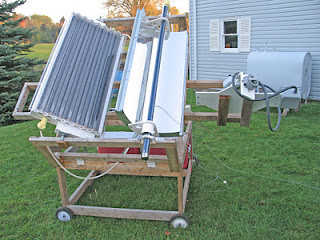
Search
The Renewable Energy site for Do-It-Yourselfers
Concentrating vs Flat Plate
Collectors for Solar Heating
|
George Plhak has done some very interesting tests that compare a DIY
flat plate collector similar to the $1K collector to a DIY parabolic
trough collector that George designed.

George's side-by-side collector test rig.
George gives the
full rundown on the test setup and the tests here...
Its very
clearly written, and I'd suggest reading it for the full story. I've
put in a few comment/observations below.
|
|
Test Setup and Data Gathering
George did a very professional job of building the test setup and taking the
test data. This is easy to say in one sentence, but not at all easy to
actually do.
The rack on which the collectors are mounted allows a true side by side
evaluation under the same conditions, and it is set up so that either or both
collectors can be set to track the sun -- very nice.
Comments on the Tests
All the tests were interesting, but, to me, these two had the most to say
about common solar heating (space and water) applications:
Fixed, glazed Flat Plate vs Tracked, Glazed Parabolic Trough
On this test, the flat plate collector was fixed in place, and the parabolic
collector tracked the sun all day. Both absorbers were glazed to reduce
heat loss -- the flat plate is glazed over the full surface, and the
concentrating collector uses a glass tube to enclose the central tube absorber.
The plot of the results is shown
on this page...
I think that for a lot of people, this test represents a real choice:
Should I build a flat plate collector and mount it in a fixed position, or,
would I get more bang for the buck with a more complex collector that tracks the
sun all day and has higher daily heat output per sqft of collector?
Looking at the plot for the test, the tracking collector out performs the
non-tracked collector both in the early morning and late afternoon -- this is
what one would expect given that the non-tracked panel is dealing with higher
incidence angles during these times, while the tracking collector is more nearly
aimed right at the sun.
I was a bit surprised that the tracking collector did not show a bigger
difference in heat produced over the full day. In the end, on this test
the tracking collector produced about 2% more heat than the untracked flat
plate. This is not a whole lot of gain to show for the extra complexity of
the tracking system.
The test was done in mid October, and would probably show more improvement
for the tracker closer to the summer when the sun is up longer.
Just to get an idea what one might expect from a tracking collector at Acton,
Ontario, the extract below is from the NREL Redbook for Lansing, MI -- more or
less the same latitude.
In Lansing, in October, a fixed collector tilted at latitude sees an average
of 3.8 KWH/m^2 per day, while a tracked collector tilted at latitude sees an
average of 4.5 KWH/m^2-day -- or, an 18% increase. The increase for
mid-summer would be more like 36%, and mid winter about 10%.
Maybe others have some incites on why we don't see a bit more difference in
heat output between the two on this test?
One might guess that the flat plate collector was more efficient, and maybe
that's true, but the next test seems to indicate they are pretty close in
efficiency.

Tracked, glazed Flat Plate vs Tracked, Glazed Parabolic Trough
On this test, both collectors were tracked to face the sun all the time.
Both absorbers were glazed to reduce heat loss -- the flat plate is glazed over
the full surface, and the concentrating collector uses a glass tube to enclose
the central tube absorber.
The plot of the results is shown
on this page...
The performance of the two collectors was very nearly identical over the day.
So, maybe, a message here is that for these two designs and with these kinds
of temperatures (50F delta temp), the basic efficiencies of the two designs are
pretty close. The main factor (I think) that tends to favor the
concentrating collector in this test is that the heat loss from the absorber
should be smaller because the absorber area is much smaller, and the evac tube
insulation used should do a good job of insulating. On the other hand, the
flat plate collector absorber receives more light because of the single layer of
glazing, and no reflective loss. Apparently, these factors tend to
cancel each other at this temperature rise. The 50F temperature rise
is in the ball park for year round water heating, and perhaps a bit low for
typical space heating -- but, right in the ball park for a lot of solar
applications.
To me, this is an important conclusion: A good DIY flat plate collector
has about the same efficiency at modest temperature rise as a good DIY
concentrating parabolic when both are tracked to the sun.
I guess that to some degree this means that you can decide which to build
based on mostly on arguments like ease of construction, maintenance, and life.
I would guess that if higher temperatures were required the lower heat loss
from the concentrating collector would win out and its performance would get
better than the flat plate. The opposite might happen for lower
temperature rises.
Stagnation Temperature
The stagnation temperature achieved by the parabolic collector with the evac
tube insulator is very impressive indeed. This might be a DIY approach to
generating useful amounts of steam. But, as George says, be careful!
George's blog entries on the testing would be a good place to leave comments...
Gary February 27, 2012

